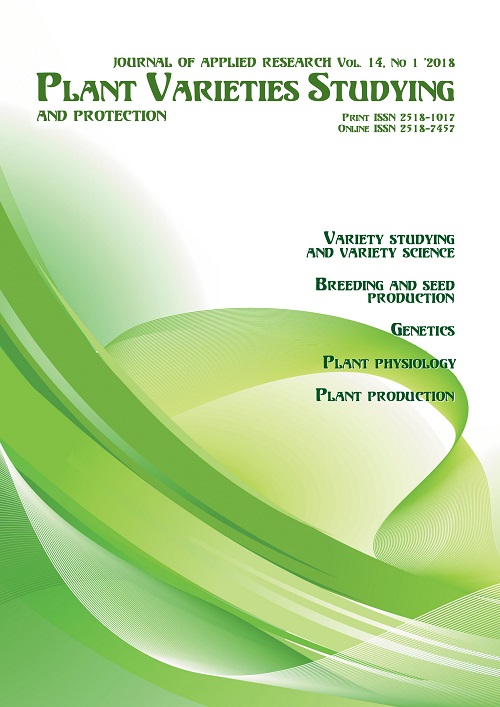Frost-resistance of the blackberry (<i>Rubus</i> subg. <i>Eubatus</i> Focke) cultivars in the Forest-Steppe zone of Ukraine
DOI:
https://doi.org/10.21498/2518-1017.14.1.2018.126521Keywords:
laboratory freezing, low temperatures damage point, bush, bud, adaptive propertiesAbstract
Purpose. To improve the blackberry assortment based on studying the economic and biological peculiarities of new cultivars and their adaptabivity under the soil and climatic conditions of the Western Forest-Steppe zone of Ukraine for the further variety research and use in breeding programs.
Methods. Laboratory, field, analytical and statistical ones.
Results. Investigations were carried out to determine the influence of variable temperatures on 25 blackberry cultivars and their frostresistance to artificially created low temperatures (25and -30 °C). The degree of shoot tissue damage of blackberry plants with low temperatures in the field was also analyzed.
Conclusions. The analysis of the degree of damage of blackberry plant shoots showed that a shoot apex appeared to be the most susceptible to the influence of low temperatures and the middle part of the shoot was most resistant. On the basis of the results of the laboratory freezing of the blackberry plant shoots, cultivars were defined to be the most resistant to the both -25 and -30 °C low temperatures (‘Sadove chudo’ and ‘Orkan’). ‘Ouachita’ and ‘Cacanska Bestrna’ cultivars were also resistant to the temperature -25 °C (their total damage score did not exceed 9.0%). It is risky to cultivate ‘Nasoloda’, ‘Black Diamond’, ‘Tornfree’, ‘Loch Tay’, ‘Triple Crown’ and ‘Black Butte Blackberry’ in the areas where the temperature can be lowering to -25 °C without taking additional agrotechnical measures to protect against damage with low temperatures. The most sensitive to the temperature of -30 °C was the ‘Black Butte Blackberry’, ‘Nasoloda’, ‘Black Diamond’, ‘Black Pearl’ and ‘Jumbo’ cultivars (damage of more than 50% shoots was noted). This temperature conditions were critical for ‘Chief Joseph’, ‘Reuben’, ‘Tornfree’, ‘Karaka Black’, ‘Black Magic’, ‘Loch Tay’ and ‘Triple Crown’. The ‘Kiowa’ cultivar was quite resistant to both temperatures. The dependence of the shoots damage degree on the scrub architectonics was determined. The cultivars with creeping shoots are more susceptible to the effect of low temperatures than those that are more upright.
Downloads
References
Sherenhovyi, P. Z. (2013). Suchasni tekhnolohii vyroshchuvannia ozhyny ta malyno-ozhynovykh hibrydiv [Modern technologies for growing blackberries and raspberry and blackberry hybrids]. Kyiv: Nilan-LTD. [in Ukrainian]
Serdiuk, O. V. (2007). Adaptability of new cultivars and hybrids of blackberry to growing conditions in the Northen Forest-Steppe zone of Ukraine. Naukovyi visnyk NAU [Scientific Herald of National Agrarian University], 116, 254–260. [in Ukrainian]
Mazur, B. M., & Sherenhovyi, P. Z. (2013). Winter-hardiness and biochemical properties of blackberry cultivars (Rubus) bred at the National University of Life and Environmental Sciences of Ukraine. Visnyk Lvivskoho natsionalnoho ahrarnoho universytetu. Ahronomiia [Bulletin of Lviv National Agrarian University. Agronomy], 17(2), 256–261. [in Ukrainian]
Finn, C. E., & Strik, B. C. (n.d.). Blackberry cultivars for Oregon. URL: https://catalog.extension.oregonstate.edu/ec1617/html
Nesbitt, M., Kamas, J., & Stein, L. (n.d.). Blackberries. URL: https://aggie-horticulture.tamu.edu/fruit-nut/files/2010/10/blackberries.pdf
Andriienko, M. V. (1992). Metodyka vyvchennia sortiv i form ozhyny [Methods of studying the blackberry varieties and forms]. Kyiv: N.p. [in Ukrainian]
Sedov, E. N., & Ogol’tsova, T. P. (Eds.). (1999). Programma i metodika sortoizucheniya plodovykh, yagodnykh i orekhoplodnykh kul’tur [Program and methods of variety studing of fruit, smallfruit and nut crops]. Orel: VNIISPK. [in Russian]
Solov’eva, M. A. (1982). Metody opredeleniya zimostoykosti plodovykh kul’tur [Methods for determining winter hardiness of fruit crops]. T. A. Pobetova (Ed.). Leningrad: Gidrometeoizdat. [in Russian]
Bublyk, M. O., Patyka, T. I., Kytaiev, O. I., Makarova, D. H., Kryvoshapka, V. A., Honcharuk, Yu. D., & Potanin, D. V. (2013). Laboratorni i polovi metody vyznachennia morozostiikosti plodovykh porid [Laboratory and field methods for determining frost tolerance of fruit plants]. Kyiv: N.p. [in Ukrainian]
Kytaiev, O. I., Lahutenko, O. T., Chornyi, I. B., & Didychuk, M. O. (2015). Frostresistance of the Ribes L. species plants in the Northern part of the Forest-Steppe zone of Ukraine. Sadivnytstvo [Horticulture], 70, 182–191. [in Ukrainian]
Downloads
Published
How to Cite
Issue
Section
License
Copyright (c) 2018 Ukrainian Institute for Plant Variety Examination

This work is licensed under a Creative Commons Attribution-ShareAlike 4.0 International License.
Starting in 2022, the copyright to the publication remains with the authors
Our journal abides by the CREATIVE COMMONS copyright rights and permissions for open access journals.
Authors, who are published in this journal, agree to the following conditions:
- The authors reserve the right to authorship of the work and pass the first publication right of this work to the journal under the terms of a Creative Commons Attribution License, which allows others to freely distribute the published research with the obligatory reference to the authors of the original work and the first publication of the work in this journal.
- The authors have the right to conclude separate supplement agreements that relate to non-exclusive work distribution in the form in which it has been published by the journal (for example, to upload the work to the online storage of the journal or publish it as part of a monograph), provided that the reference to the first publication of the work in this journal is included.

























 Ukrainian Institute for Plant Varieties Examination
Ukrainian Institute for Plant Varieties Examination  Селекційно-генетичний інститут
Селекційно-генетичний інститут Institute of Plant Physiology and Genetics of the National Academy of Sciences of Ukraine
Institute of Plant Physiology and Genetics of the National Academy of Sciences of Ukraine
 The National Academy of Agrarian Sciences of Ukraine
The National Academy of Agrarian Sciences of Ukraine